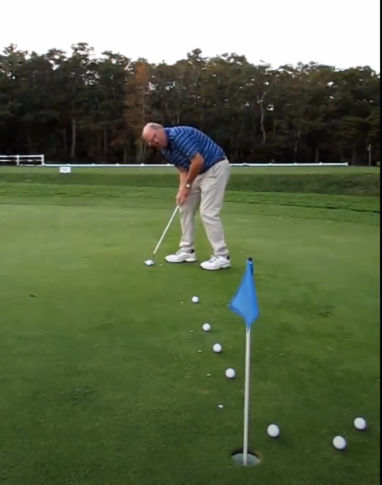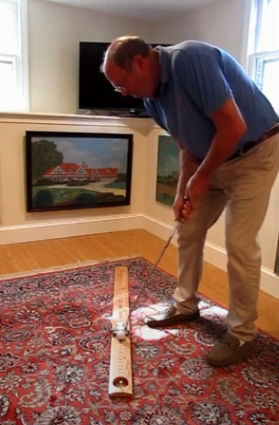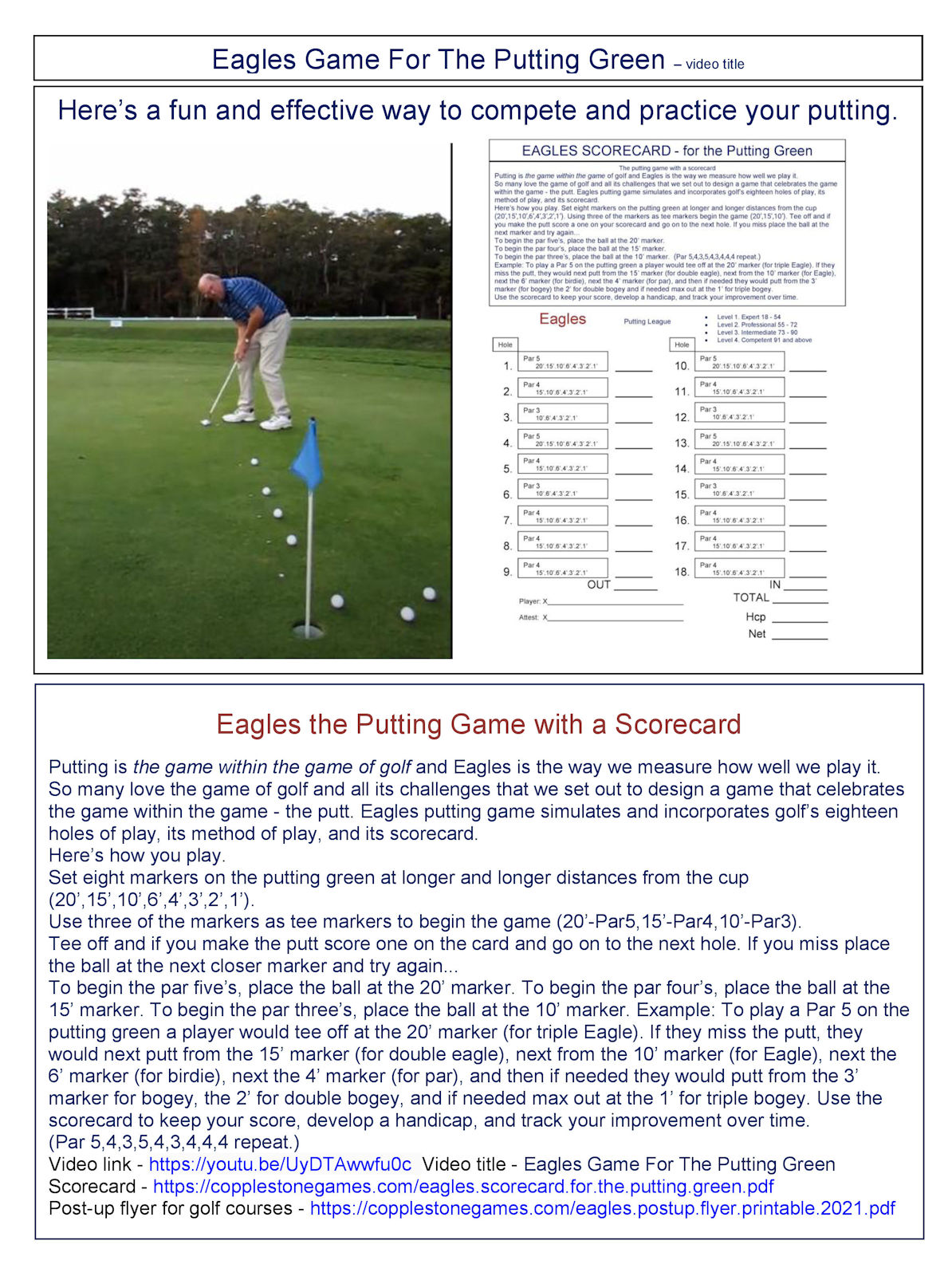Consider this, eyes behind the ball, down the line putting method.
OSTERVILLE, Mass. - Nov. 8, 2021 - PRLog -- When I had this idea a few days back, I took it to the golf course. This putting stance felt very comfortable and seemed to improve my putting accuracy right from the start.
I would suggest that if your happy with your putting stay with it but if you sometimes struggle with it you might want to give this experiment a try.
The development of this idea is attributed to a golf tips video by Tom Seguto that I happened to watch. The video was demonstrating Ben Hogan's Magic Elbow swing method of turning his right elbow into his side when setting up for his backswing. I went to the driving range to give it a try and it did seem to work fine. When I finished there, I thought what would this tucked elbow feel like when putting? So, I went to the putting green and as I worked out a comfortable stance to accommodate bringing my elbow into my waist, it led me to naturally open my feet out to 45 degrees, move my head back behind the ball six inches or so and over the line. I thought it felt great.
After two weeks of using this method, I performed an experiment of putting twenty balls from three different locations. I used ten balls with the Conventional method and ten with the StoneCold method at each of these locations. The resulting average distance from the cup measurement was closer to the cup using the StoneCold method by 2% on the 10-foot uphill putts, 20% on the 8-foot sidehill putts, and 40% on the 34-foot sidehill putts.
The goal is to have more of the close putts go in and reduce the number of three putts.
Using the StoneCold putting method, there were four one putts.
Using the Conventional method, there were two one putts.
So far, I'm finding that there is a positive measurable result using the StoneCold method and a general putting improvement using either method due to the focus of the experiment.
After three weeks of using the new StoneCold (Magic Elbow) Putting Method, I adapted my concept for the Eagles for the Putting Rail Game to the Eagles for the Putting Green Game because it dawned on me that using the Eagles scorecard would be a great way to conduct another experiment to compare the StoneCold method with the Conventional method.
Here are the early results of the StoneCold putting method vs. the Conventional method in 18 holes of play using the Eagles scorecard and rules of play.
Game #1: Conventional won by 4 strokes in Stroke-play and Conventional won when it was 2 up with one to play in Match-play.
Game #2: StoneCold won by 3 strokes in Stroke-play and StoneCold won when it was 1 up with one to play and Conventional failed to tie on the 18th hole in Match-play.
Game #3: StoneCold won by 4 strokes in Stroke-play and StoneCold won when it was 2 up with one to play in Match-play.
http://www.youtube.com/watch?v=v8XMiEQD13U
Part 2
Eagles Game for the putting green
Putting is the 'game within the game' of golf and Eagles is the way we measure how well we play it.
So many of us love the game of golf and all its accompanying challenges that we set out to design a game that celebrates the game within the game – the putt.
Eagles putting game simulates and incorporates golf's eighteen holes of play, its method of play, and its scorecard.
How did the StoneCold putting method lead to the Eagles putting game with a scorecard?
The idea of adapting the Eagles for the Putting Rail scorecard and rules of play to the Eagles for the Putting Green scorecard and rules of play struck when after experimenting with the StoneCold (Magic Elbow) Putting Method for three weeks I wanted to conduct another comparison experiment.
It dawned on me that adapting the Eagles putting rail scorecard for the putting green would be a great way to do it.
Here's how you play.
To begin with, set eight markers on the putting green at progressively longer distances from the cup (20',15',10',6',4',3',2',1',). To commence the game, use three of the markers as tee markers (20',15',10'). Tee off and if you make the putt, score one on the card and move on to the next hole. If you happen to miss, just place the ball at the next closer marker and make another attempt…
To start the par five's, place the ball at the 20' marker, the par four's at the 15' marker, and the par three's at the 10' marker.
Example: To play a par 5 on the putting green, a player would tee off at the 20' marker (for triple Eagle). If they miss the putt, they would next putt from the 15' marker (for double Eagle), next from the 10' marker (for Eagle), next the 6' marker (for birdie), next the 4' marker (for par). And then if necessary, they would putt from the 3' marker for bogey, the 2' marker for double bogey, and if needed max out at the 1' for triple bogey.
Use the scorecard to keep score, develop a handicap, and track your improvement over time.
(Par 5,4,3,5,4,3,4,4,4 repeat)
I'm finding that the more I play these two putting methods in comparison to each other, the more comfortable and confident a putter I am becoming no matter which I'm using. However, I'm preferring (so far) the StoneCold method perhaps because it seems to be a more athletic and feel sort of a set up and stroke.
The games' scores may vary depending on the difficulty of the cup location on the putting surface.
Your best average Putting Score is found by taking the average of the best eight of your last twenty Eagles scores.
Eagles scorecard for the green
Eagles post-up flyer for golf courses
Eagles Scorecard for the Putting Rail
copplestonegames.com
https://youtu.be/UyDTAwwfu0c
Contact
Copplestone LLC
David W. Copplestone
***@verizon.net
Photos: (Click photo to enlarge)



Read Full Story - A StoneCold Putting Method (Magic Elbow) | More news from this source
Press release distribution by PRLog
A StoneCold Putting Method (Magic Elbow)
By:
PRLog
November 08, 2021 at 09:47 AM EST
Data & News supplied by www.cloudquote.io
Stock quotes supplied by Barchart
Quotes delayed at least 20 minutes.
By accessing this page, you agree to the following
Privacy Policy and Terms and Conditions.
Stock quotes supplied by Barchart
Quotes delayed at least 20 minutes.
By accessing this page, you agree to the following
Privacy Policy and Terms and Conditions.